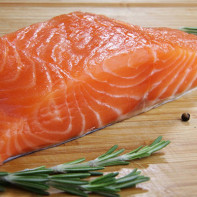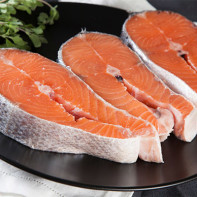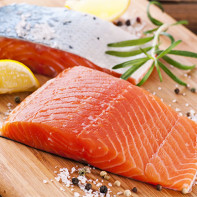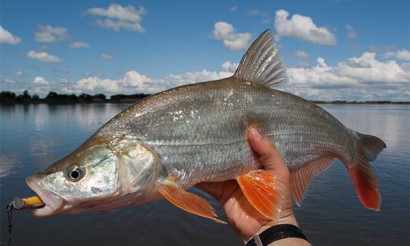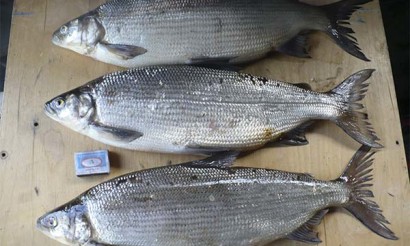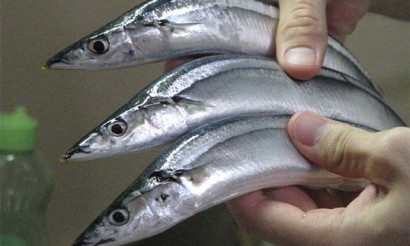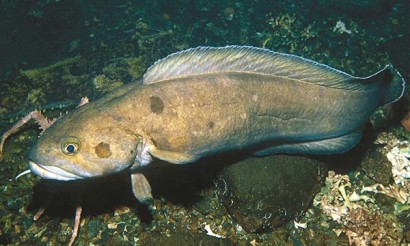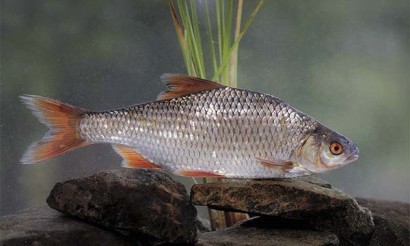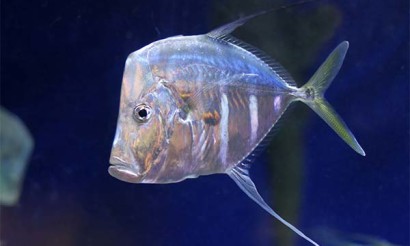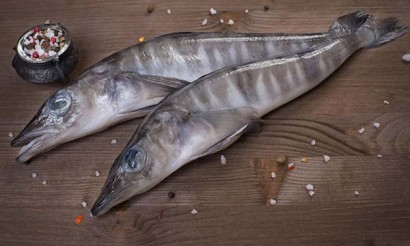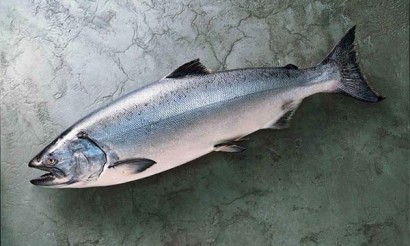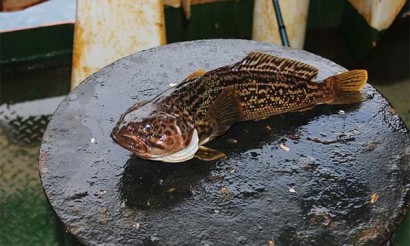Salmon fish: photo, description, useful properties and recipes
What is happiness? Everyone has his own criteria: some have money, children, love, etc. But no matter what a person dreams about, no matter what he wants, happiness is impossible without health. That's why most people are looking for ways to preserve and maintain it, to enjoy life as long as possible. And nutrition is an important part of staying healthy, because what goes into the daily diet has a direct impact on the body. In this regard, dishes on the table should be varied and healthy. It is necessary to include meat and, of course, fish delicacies in the menu, because it is sea creatures that can bring incredible benefits to humans. One of these unique and useful representatives of the sea depths is the salmon. What is his secret and what kind of fish it is, let's figure it out!
- Salmon: what kind of fish, how it looks and where it is found
- What is the difference between salmon and other fish
- From salmon
- From trout
- From salmon
- Composition and calories
- How salmon is useful
- General benefits
- For Women
- For Men
- In Pregnancy
- For breastfeeding
- For children
- Slimming down
- Which salmon is healthier: farmed or wild
- Salmon Caviar Benefits
- How to salt
- Is salmon milk useful?
- Benefits and harms of smoked salmon
- The benefits of canned salmon
- Salmon fat: benefits and harms
- Salmon in medicine
- For Diabetes Mellitus
- For pancreatitis
- For gastritis
- At gout
- For cholecystitis.
- Harm and contraindications
- How to choose and store
- Can I Freeze?
- How to clean salmon
- How to cook salmon well: Recipes
- In the oven
- In the frying pan
- On the grill
- On the grill
- In the steam cooker
- What to cook with salmon: Recipes
- Salad
- Soup
- Pasta
- Tartar
- Quiche
- Cutlets
- Bruschetta
- Riette
- Carpaccio
- Pate
- Roll
- Shashlik
- How to salt salmon well at home
- Can we eat raw salmon?
- Can we give salmon to animals?
- Interesting Facts
Salmon: what kind of fish, how it looks and where it is found
At the beginning, it should be noted that salmon is not a separate fish, but an entire family of representatives of the Salmon family. It includes sockeye, coho, chum, whitefish, chinook salmon, omul, grayling, pink salmon, salmon and others. Science subdivides salmon into whitefish, grayling and salmon. Experts divide the latter into Pacific salmon, noble salmon, and char.
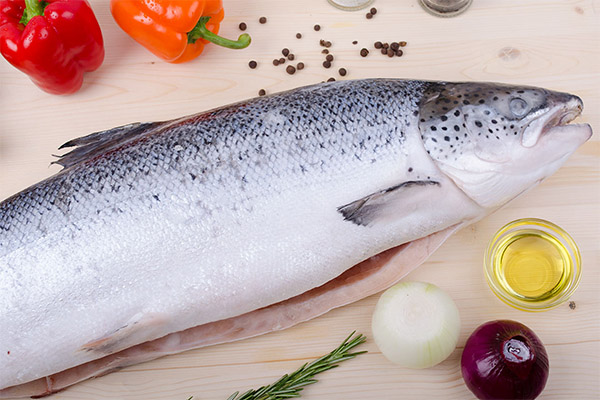
The group of Pacific salmon includes humpback salmon, coho salmon, sockeye salmon, chum salmon and chinook salmon.
Noble salmon are trout and salmon.
As for the family itself, it has been known since the Cretaceous period, so salmon is considered an ancient fish.
The size of salmon can also be different and can reach 200 cm, and the weight can reach the mark of 50 kg. Salmon have elongated and narrow bodies, with compressed flanks. The scales are silvery in color with small spots, and the middle of the body is decorated with a dark stripe stretching along it. In general, the abdomen is always light-colored, but the back is darker. On the back of the fish next to the tail is a fat fin, which has no spots and rays, the other fins have rays, but lacking teeth. The head of the salmon is cartilaginous. The teeth are sharp. Fish also have transparent eyelids.
Salmon have an amazing ability to adapt to habitat conditions, and they can also change their color to red. This occurs mostly in males before the spawning period.
Salmon live in rivers, lakes and oceans. They have been seen in the waters of the Pacific and Atlantic, in Kamchatka, the Far East, Yakutia and Siberia, Lake Baikal, Lake Onega, in northern Europe. They occur in both fresh and salt water, but spawn in running rivers, where they swim upstream. It is this fact that has served to distinguish this species of fish as migratory. They eat herring, zooplankton, vendace, smelt and small crustaceans.
The most popular representatives of the salmon are salmon, which in fact is called a salmon, and trout, which, although different, but also part of this friendly family.
How salmon differs from other fish
Salmon is a "collective image", but it also has its own distinctive features:
- The fins on the back and abdomen have rays, but do not possess spines;
- the body has dark spots;
- There is a longitudinal dark stripe across the body;
- the skeleton does not ossify completely, and therefore the head retains cartilaginous tissue;
- there is a transparent eyelid;
- light abdomen, dark coloration of dorsal part;
- a powerful jaw with sharp teeth.
These are common characteristics of salmon, but still some fish have their own striking distinctive features.
From salmon
Salmon - is one of the most popular members of the salmon family, called Atlantic or lake salmon. This fish is often so called, so the question of distinction in principle can not exist. But there are still some features that distinguish it:
- One of the largest species of salmon. The length can reach 100 cm, and weight - exceeds the mark of 45 kg. Also, the body of salmon is covered with even, silver-colored scales, but dark spots are almost absent.
- Habitats are considered the northwest Arctic Ocean, north of the Atlantic Ocean and the Baltic Sea.
From trout
Trout is also the common name for some fish of the Salmon family. Several species are distinguished - it is rainbow, lake and river trout. It has the following differences:
- The body is rounded, as it is more "chubby."
- The muzzle seems truncated.
- Scales are small.
- The paired fins are more rounded.
- Trout have different colors, which is related to water quality. Most often its back is colored in green and olive, and the sides - in green-yellow. The abdomen is light.
- On each side, on the sides, there are pink nacreous stripes.
- Home for trout are lakes, rivers or streams.
- The fish may or may not be considered passable.
- Trout eggs are larger in size than other salmonids, but they are much smaller. So one individual can only reproduce 1,000 eggs.
- The meat is colored pink, red or pale, but it contains half as many calories as other fish of this species.
These are the characteristics that distinguish the trout species from others.
From the pink salmon
Pink salmon - is one of the subspecies of Pacific salmon, but its smallest representative, although it is the most numerous. Pink salmon does not grow over 70 cm and does not exceed the mark of 2 kg. The fish got its name because of the hump on the back of the male representatives, which appears during the mating season.
The body of the pink salmon is silvery with oval dark spots. The tail is V-shaped, the mouth is white. These fish eat very caloric foods, so they quickly gain weight. Pink salmon spend the winter in the water with the temperature not dropping below +5°C. Its roe is large, but pale. The meat is delicious and healthy, however, as in all salmon.
Composition and calories
Salmon is considered one of the most useful products, as well as all kinds of red fish, to a variety of which it belongs. Its composition includes a large number of useful nutrients, among which we can highlight the presence of:
- retinol
- thiamine;
- riboflavin;
- niacin;
- acids - pantothenic and folic acids;
- pyridoxine;
- folic acid;
- vitamin C;
- cholecalciferol;
- tocopherol;
- magnesium;
- phosphorus;
- sodium;
- iron;
- selenium;
- zinc;
- calcium
- copper;
- manganese;
- potassium;
- iodine;
- omega-3;
- omega-6;
- amino acids.
The nutritional value of salmon is expressed by the following values: 20 g - protein, 7 g - fat, 0 g - carbohydrates. These figures apply to 100 g of fresh fish. The caloric value per 100 g is about 145 kcal.
The composition of salmon, rich in unique components, determines its benefits for the human body. The consumption of dishes from such meat will help to prevent many diseases and maintain health.
How salmon is useful
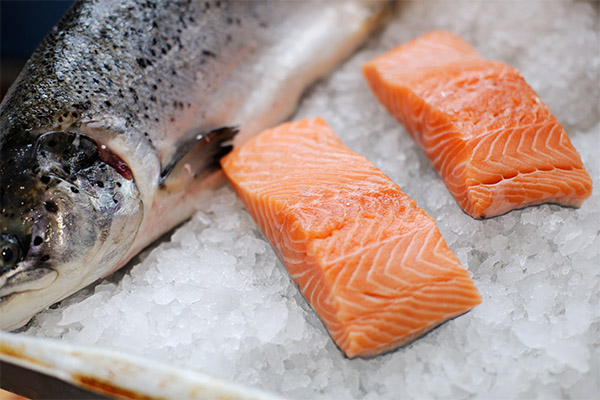
General benefits
Rich in micro and macronutrients salmon is very good for human body. Its effects extend to the heart, nervous system, brain activity, vision and almost the entire body. It's all about vitamins and minerals. Thanks to them, this fish has the following effects:
- removes inflammation;
- strengthens the immune system;
- prevents the formation of blood clots leading to heart attacks;
- strengthens the cardiovascular system;
- regulates the rhythm of the heart muscle;
- prevents the development and appearance of cancer;
- activates brain activity;
- improves memory;
- strengthens bone tissue, hair;
- improves dental health;
- regulates the nervous system;
- Prevents the aging process;
- Improves the condition of the skin and mucous membranes;
- normalizes blood pressure;
- restores the elasticity of blood vessels;
- Increases the level of useful cholesterol;
- cleanses the body of harmful substances;
- reduces the risk of diabetes;
- Improves the state of the gastrointestinal tract;
- prevents arthritis;
- Reduces the risk of yellow spot degeneration, thereby maintaining healthy eyes;
- Normalizes thyroid activity.
These qualities make salmon not only a tasty product that can delight a fish gourmet, but also very useful. But much depends on the individual characteristics of the body.
For women
Salmon will conquer the fair sex with its delicate taste and easy digestibility. It will also have a calming effect, will help in the fight against excess weight, eliminate fatigue and depression, prevent gynecological diseases, normalize the activity of the reproductive system and eliminate the risk of breast cancer. And, of course, women will love the fish's ability to take care of their skin, hair and nails. Salmon can rejuvenate the skin and improve its condition, keeping it firm and elastic. It will help to strengthen hair and nails, thus improving their condition and the overall mood of women seeking to maintain their beauty and youthfulness as long as possible.
For men
The strong half of mankind also need to maintain their health and fitness in excellent condition. And in this can help all the same salmon. This fish will recover strength after physical activity, improve metabolism processes, prevent cardiac diseases, will save from early baldness, speed up the process of getting rid of excess weight, reduce the risk of prostate cancer. Fish will prevent aging, which means it prolongs youthfulness and preserves male power. Therefore, the stronger sex should at least once a week to arrange a "fish" day with dishes from the delicate meat of salmon.
When pregnant
The period of childbirth is an important moment in the life of every woman, when the responsibility for the formation of the future man fully lies on the mother's shoulders. Therefore, it is very important to monitor the proper diet, the products must bring only benefit and reduce the risk of fetal abnormalities and complications in general.
Salmon during pregnancy helps:
- regulate water metabolism and hemoglobin levels;
- increase the strength and strengthen the condition of teeth and nails;
- Strengthen bone tissue;
- flush harmful substances out of the body;
- normalize blood pressure;
- lower cholesterol levels;
- Strengthen the heart muscle.
All these qualities allow the product to become an indispensable helper to maintain the health of the expectant mother and baby, if it were not for one "but". Salmon can contain mercury, which can harm the baby and the mother even in small amounts, increasing the risk of complications during this period and the development of fetal abnormalities. Therefore, it is better if the consumption is moderate or a woman chooses the safest varieties of fish. In addition, if the salmon is in the food basket, it should be baked, but not eaten raw, smoked or salted, as it will only increase the risk of unwanted consequences.
Of course, each mother decides for herself what to eat, but still, sometimes it is worth to refuse a favorite dish, so as not to harm the little man.
When breastfeeding
During lactation, it is fish that will help a woman to recover and saturate her milk with all the necessary elements for the proper growth and development of the child.
Salmon in this case has a double effect, as well as during pregnancy. It will help to strengthen the bones, teeth, hair of mother and child, improve immunity, regulate the nervous system, promote the proper formation of the body as a whole. But because of the presence of mercury, fish can become dangerous. In addition, some producers during the cultivation of individuals use antibiotics and other harmful substances that will only have a negative effect. Also red fish can provoke allergic reactions.
In connection with these data, experts recommend refraining from eating salmon, or eating it with great caution, taking into account the condition of the baby and the absence of contraindications.
For children
Children's body badly needs all the vitamins and minerals contained in salmon, because they regulate the nervous system, and brain function, and vision, and the state of bones, teeth, skin and hair. Also fish gives strength and vigor, helps to cope with stress, improves memory and vision, helps to improve attention and properly formed in general.
But still this product can cause allergies. It belongs to the fatty species, so up to the age of 3 years it is better to refuse to eat such a dish. Then it should be introduced into the diet gradually, starting with 50 grams and later increasing the rate to 100 grams. Experts do not recommend eating salmon more than once a week at children's age. It is best to give your baby steamed or baked fish, but the salted and smoked left for later. In any case, before starting the introduction to the diet of this product it is necessary to consult with a specialist.
When losing weight
During a diet, it is very desirable to get rid of excess volume as quickly as possible, but at the same time to eat tasty, useful and varied. Salmon is a good dish that not only gives the pleasure of taste, but also brings health benefits and speeds up weight loss.
It contains omega-3 acids that help break down fats, vitamin D, which supports bone tissue and the nervous system, B6, which helps the absorption of protein, is responsible for regulating hemoglobin levels, for increasing muscle and heart function, B12, which helps the accumulation of protein and oxygenation of the body. These and other nutrients in combination help to saturate the body of a person on a diet with all the necessary vitamins and minerals, while helping to lose excess weight faster, improve skin condition and do no harm. But you should eat fish about 4 times a week, and then the result will not make you wait long!
Which salmon is healthier: farmed or wild
Salmon is a healthy fish and in great demand. That's why it is not only caught in its natural habitat, but also farmed. Experts have long debated whether farmed salmon is as useful as its wild counterpart.
First of all, it is worth noting that in fish farms salmon are fed artificially, i.e. they include antibiotics and other harmful substances in their usual diet, which affects the useful qualities of fish. In addition, they may contain organochlorines which provoke the growth of malignant tumors.
Another difference between species is the color of meat, which in wild fish has a red color, and in farmed - grayish. In this regard, cunning industrialists add dyes that are also not good for the human body. Salmon that lived in "free" waters tastes much better than the one raised in the "pen", because the latter contains chemical compounds that affect the taste.
In terms of price, farm pets are cheaper, but whether it's worth paying less for health risks is up to everyone to decide!
The benefits of salmon roe
What celebration is without many people's favorite red caviar of salmon fish? This dish was on the tables of kings and nobles. It gained its popularity only in the XIX century, and before that time people simply threw away the "fish eggs", considering them inedible entrails. But then red caviar won the hearts (or stomachs) of gourmets the world over.

This delicacy captivates with its taste, but no less striking are its useful properties, which include:
- Prevention of atherosclerosis and rickets;
- immunity enhancement;
- Strengthening of the bone skeleton, hair and nails;
- maintenance and rejuvenation of the skin;
- regulation of the circulatory process;
- decrease in blood pressure;
- normalization of the cardiovascular system;
- increase of potency;
- regulation of the nervous system;
- increase in hemoglobin;
- improvement in vision;
- neutralization of cancer cells;
- activation of brain activity.
These properties of red caviar are explained by the presence in its composition of the following useful substances:
- B vitamins, A, E, C, D;
- sodium;
- omega-3;
- sulfur;
- phosphorus;
- iron;
- calcium;
- zinc.
But still, despite all the benefits and uniqueness of red caviar, we should not forget about the contraindications of the exquisite product, which include:
- individual intolerance;
- kidney disease;
- urolithiasis;
- children under the age of 3 years;
- hypertension (with caution);
- coronary heart disease (with caution).
To avoid possible risks, experts recommend eating no more than 5 tsp. of caviar per day, while choosing a high-quality product. Cheap caviar can be dangerous due to its formaldehyde content, which is produced by the decay of urotropine, a preservative used to extend shelf life by unscrupulous producers. The real product, eaten in moderation, can bring only good!
How to pickle
To enjoy red caviar, you don't have to run to the store. If there is caviar in fresh form, you can salt it yourself, the benefit of no special tools and degrees of chef is not needed. It is only necessary to follow the recipe and use the advice of professionals:
- If a person decides to salt caviar himself, then first he will have to buy the fish, which actually contains the precious product. It is necessary to choose a female salmon. In appearance, the female fish is more rounded, with a smaller head and has no sharp and sharp ends, unlike the male fish. If a really female fish is chosen, it will 100% have caviar in it, because. Salmon are caught just before spawning. Then the fish should be thawed at room temperature and only then begin the process of preparation and salting.
- When you take out the roe, you will notice that it is all in a kind of film or crust, which should be cleaned by hand, being careful not to damage the eggs. Place the cleaned product in a bowl with cold water and start stirring it with a wooden stick, rotating it to one side. The rest of the roe will be wrapped around the stick. Then put caviar into a colander, covered with a layer of gauze, and after all liquid has drained off, stir it again with a skewer, but on a dry cloth. Thus, all the damaged "testicles" and films will be on the gauze.
- The next step is to make a marinade or marinade. To make it, you need water, the volume of which should completely cover the caviar. You also need sugar at the rate of 2 tsp. per 250 ml. of water, and 2 tbsp. of salt per the same amount of liquid. After mixing all the products, the brine should be boiled and cooled to room temperature, because too hot water can simply curdle the caviar.
- At the final stage, the caviar should be filled with the prepared warm marinade and allowed to stand for about 15 minutes. Then flip it on gauze and let the liquid drain (this can take a long time). After the product to transfer to glass jars, which inside pre-lubricate with vegetable oil, and put in the refrigerator.
In 4 hours the red caviar will be ready. You can please guests and loved ones.
Is the milk of salmon useful?
Female salmon give humans useful and tasty red caviar, but the males are not left out: they contain unique in their composition, which is also very useful for the human body.
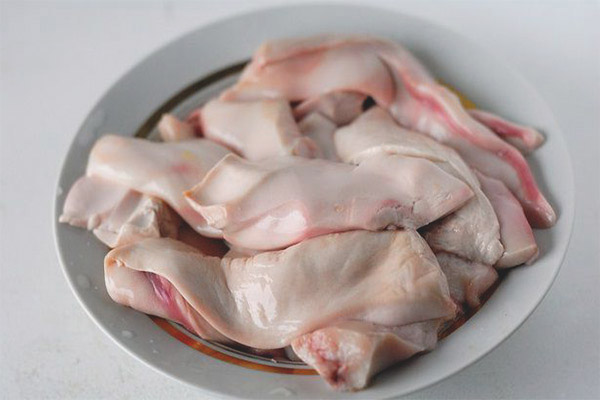
The molluscs are the seminal gland that can be found specifically in males. They are colored white, thanks to which they got their name.
Milk contains:
- retinol;
- acids - nicotinic, ascorbic, folic acid;
- B vitamins;
- tocopherol;
- phosphorus;
- sodium;
- potassium;
- magnesium;
- iron;
- polyunsaturated fatty acids.
These constituents have determined the beneficial effects of dairy, which lie in such abilities as:
- regulating the work of the heart and blood vessels;
- maintaining the elasticity of the walls of blood vessels;
- reduction of the amount of harmful cholesterol;
- regulation of CNS and brain function;
- prolonging the effects of certain medications (e.g., insulin);
- immunity improvement;
- normalization of glucose levels;
- regulation of the hematopoiesis process;
- Strengthening of bone tissue;
- liver cleansing;
- protection against ultraviolet light;
- improvement of skin condition;
- Strengthening of hair and nails;
- increase in potency;
- increase sexual desire;
- prevention of diseases of the genitourinary system.
As for the harm, then, except for individual intolerance of the product, there is nothing to add to this list!
Thus, smoked salmon is really useful for the human body and worthy to take a place of honor among fish delicacies.
The benefits and harms of smoked salmon
Many people like to treat themselves to the delicious smoked salmon meat, but not everyone thinks about the harms and benefits of this dish. In order to assess its true impact on the body, you should first understand the methods of smoking fish. There are three of them: cold, hot and the method of smoking with the help of "liquid" smoke.
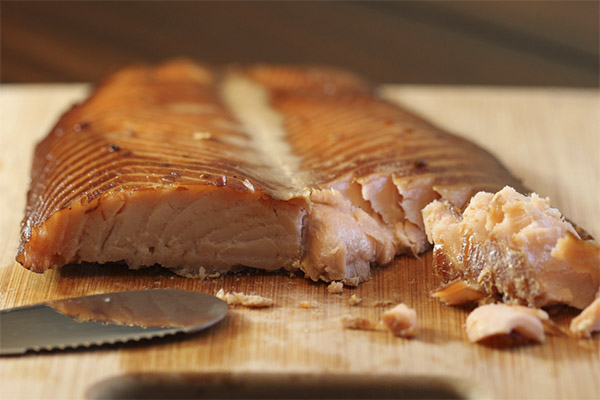
- The first method uses the processing of fish at a temperature of 20 to 30 ° C.
- The cooking temperature in the second case can range from 45 to 120°C.
- The third method involves the use of artificial liquid, which gives the fish or meat the taste and smell of smoked product.
All three methods are popular, but only the fish cooked in the first way, i.e. cold method can be beneficial for a person. It is the cold smoking method that preserves most of the useful nutrients, and there are many of them in smoked salmon:
- vitamins E, D, B12;
- manganese;
- iron;
- zinc;
- selenium;
- fluorine;
- calcium;
- magnesium;
- potassium;
- omega-3 and -6;
- phosphorus.
This composition allows the product to have the following effects on the body:
- Reduce the risk of cardiovascular disease, asthma, psoriasis, arthritis.
- Eliminate inflammation.
- Prevent the development of some cancers (such as prostate cancer).
- Normalize the work of the brain.
But for all its advantages, experts still do not recommend abusing such food, because the hot method of smoking accumulates a sufficient number of carcinogens in the food, leading to cancer. The cold method is also dangerous for parasite infestation, because the temperature of the product is too low. Well, the use of "liquid smoke" - is a chemical process in general, which will only aggravate the condition of the body, bringing it absolutely no benefit, but harm - quite likely.
Also do not forget that this kind of salmon is harmful to people who have GI diseases, kidney and liver disease. Pregnant and lactating women also do not recommend the product, as well as children under 5 years old.
But this does not mean that smoked salmon should be rejected. Experts believe that if you eat smoked delicacy about 2 times a week for 100-150 g per day, there will be no harm to the body.
The benefits of canned salmon
Canned salmon is another delicacy made from the meat of a unique fish. In fact, this is a very tasty and really useful dish, since canning preserves almost all the useful substances of the fresh product.
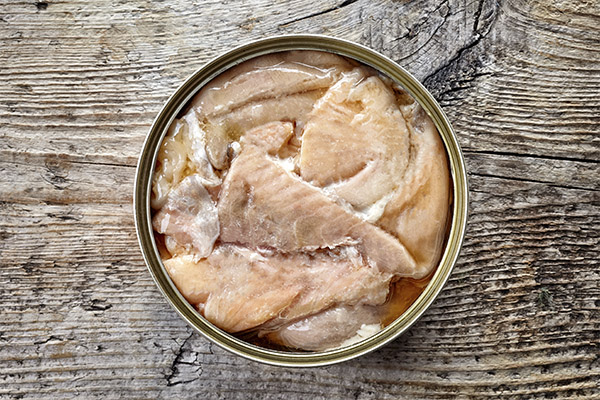
In canned this fish can be found:
- cyanocobalamin;
- pyridoxine;
- nicotinic acid;
- calcium;
- potassium;
- selenium;
- magnesium;
- phosphorus;
- omega-3.
These vitamins and minerals help people cope with metabolic disorders of diabetes and prevent the onset of Parkinson's and Alzheimer's disease. They can also maintain and improve the appearance of the skin, strengthen hair and nails, support the human bone skeleton, prevent the aging process, regulate the nervous system, hormone levels in adolescents, restore vision, protect against thrombosis, lower blood pressure, enhance immunity and maintain the intestinal microflora.
It is also worth noting that, having bought canned fish, you should not worry about where you got the fish itself: at the farm or in the sea. Wild salmon is used to make canned food, and therefore the canned product is recognized as the most useful dish, the use of which is sure to restore and maintain health, of course, if there is no individual intolerance.
Salmon fat: benefits and harms
Probably everyone since early childhood has heard about the benefits of fish oil. And this is not just because. This product is really very useful for human health. Due to the content of omega-3 and omega-6 acids, vitamin D, it can have a restorative effect, prevent inflammatory processes, regulate lipid levels. It can also destroy cholesterol plaques, reduce the risk of cardiovascular diseases, prevent rickets, promote strong bones and healthy bone skeleton formation. It prevents arrhythmias, returns elasticity to blood vessels, forms brain cells, and normalizes thyroid function.
It would seem that the product has no contraindications, but there are risks of negative reactions after its consumption. First of all, it contains cholesterol, so you should take the fat in a strictly specified dose. In addition, salmon contains mercury, which is very dangerous for people of all ages and genders, and there is a chance that the dangerous element can also be found in this product. Therefore, only high quality fish oil should be purchased, as reputable companies and medical corporations cleanse the product of the harmful and dangerous substance.
Salmon in medicine
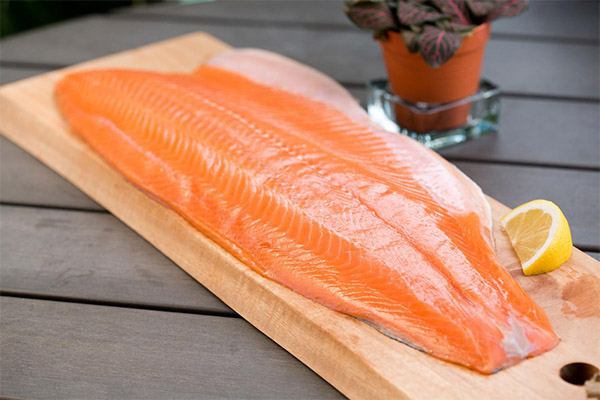
Delicious fish has gained its popularity not only as an amazing dish in the hands of a skilled chef, but also as a cure for many ailments. Its meat will be useful for the following diseases:
- increased cholesterol;
- atherosclerosis;
- diabetes;
- arthritis;
- inflammation of the skin;
- diseases of the kidneys;
- Tissue injuries of various kinds;
- leukemia;
- cancer of the breast, prostate, ovaries, brain;
- decreased immunity;
- disorders of the nervous system;
- loss of hair;
- memory impairment;
- vision problems;
- aging process;
- threat of heart attack and stroke;
- arrhythmia;
- hypertension;
- depression;
- yellow spot degeneration;
- inflammation of the joints.
Thus, salmon has its magical healing qualities, affecting almost all areas of the human body. But some serious diseases are worth talking about separately.
For diabetes mellitus
Diabetes mellitus is the reason for the abrupt prohibition of many dishes that can harm the patient's condition. But this does not apply to salmon. Moreover, doctors recommend to include in the menu of patients such a product on a mandatory basis, but not more than 150 g per day and limit consumption to two meals per week. This is due to the useful amino acids and minerals that help reduce glucose levels, help remove harmful substances from the body, reduce the risk of cardiovascular disease, strengthen the immune system and avoid problems with the musculoskeletal system.
In this case, it is better if the fish is served in a baked or canned version. In this case, the use of salmon promises only benefit and reduction of possible unpleasant consequences and worsening, provoked by diabetes.
Important: The glycemic index of fresh salmon is 0 units.
For pancreatitis
When pancreatic inflammation doctors recommend refusing fatty fish, but salmon is acceptable because of its content of unique nutrients that can improve metabolism and lower cholesterol levels. However, you should choose fish with less fat content and serve it baked, boiled or stewed. The daily rate, according to doctors, should not exceed 200 grams. Once a week the consumption of salmon will have a favorable effect on the patient's body and will not cause any harm. But in any case it is worth to consult with a specialist about the possibility of eating fish.
For gastritis
Salmon in such a disease as gastritis is more of a useful product. It is perfectly digested, contains protein, which is necessary for the patient, has a beneficial effect on the mucous membranes, saturates the body with useful micro- and macroelements, improves digestion. But still many salmon fish is a fatty product, which is contraindicated in such a disease. So it is worth choosing less fatty varieties, and if we use salmon, then only cooked steamed or in soups, and from the smoked, salted and canned versions of dishes is worth and abandoned altogether.
In case of gout
Gout is a disease in which the body releases a large amount of uric acid. Its crystals are deposited on the joints. To remove the painful sensations and prevent attacks, it is necessary to strictly follow a diet that includes foods that can reduce purine levels. This is why salmon is not recommended as a regular meal in the patient's diet. Sometimes you can indulge yourself with a small piece of fish meat, but to do this weekly in no way possible, because salmon contains a large amount of purines and can lead to complications in the patient's condition.
In cholecystitis
When the walls of the gallbladder become inflamed and the outflow of bile is disturbed, cholecystitis occurs. When this disease occurs, it is very important to follow a strict diet aimed at eliminating bile from the body. Fish, although it is a useful product for humans, but some varieties are prohibited for patients with pancreatitis, and salmon is among them. Therefore, the use of salmon with such a disease is prohibited in any form.
Harms and contraindications
All foods, healing herbs, medicines have two sides - positive and negative. And there are no exceptions. Therefore, and salmon, whose rich composition can have an amazing effect on human health, also has the following contraindications:
- individual intolerance;
- allergies;
- children under the age of 3 years;
- pregnancy and lactation period (with caution);
- gout;
- pancreatitis.
In other cases, preference should be given to wild fish, which will really benefit and do not conceal the dangers of possible chemical "poison" contained in individuals raised in fish farms.
How to Choose and Store
Choosing the right salmon will help to improve your health and taste the real flavor of tender meat. To ensure that dinner or lunch was not spoiled, it is necessary to follow the advice of professionals to help make the right choice:
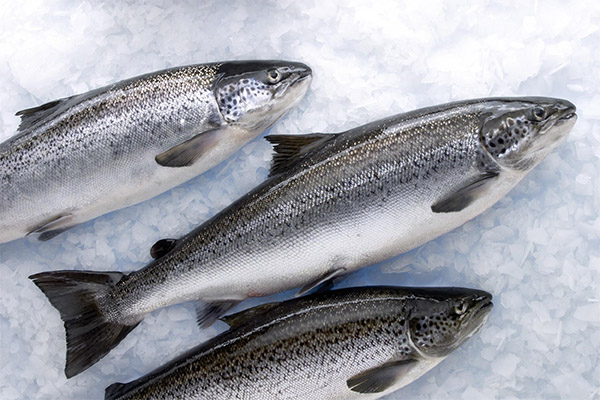
- It is preferable to buy fresh fish, as it is able to "tell" about its quality much better than frozen.
- The smell should remind you of a salty sea.
- The color of the salmon flesh is a delicate pink color, and a paler color indicates that the product has been overfrozen. A bright and saturated color indicates the use of dyes.
- It is better to buy fish with its head, since the clear and unclouded eyes point to the freshness of the product.
- When selecting steaks, you can lightly "press" the meat with your finger, the dimple from which in fresh salmon quickly regains its shape.
- If you can see white streaks on the flesh, you should refuse to buy salmon, because it must have been artificially raised.
- Wild varieties of fish are purchased from the last month of winter to the last month of summer. In other cases, a "farmed" representative is sold.
- When choosing salmon in a vacuum pack, you should read the composition, where there should be only fish and salt, and the water content in the product itself is inadmissible.
These expert recommendations will help in buying real, tasty and healthy salmon. But that is not all! Buying a good product, in this case red fish, you need to store it the right way. The basic rules:
- Salmon should be stored on the top shelves of the refrigerator for no more than 5 days.
- During the shelf life, the fish should not be removed from its packaging. It can be stored unopened for no longer than 10 days.
- Salted salmon can be stored for about 3 weeks.
- Fish should be kept separate from other foods and wrapped in foil.
- Chilled product will keep better on an ice cushion in the upper zone of the refrigerator.
- To increase the shelf life of the salmon, it can be soaked with a cloth soaked in vinegar.
Using these rules, you can keep the product fresh and therefore healthy.
Can I Freeze
Salmon can be frozen very well. Its storage temperature should be -18°C or -20°C. Then the storage time can reach 4 months.
To freeze fish, you should make sure it is fresh, and if you bought it already frozen, you should not let it defrost and put it in the freezer immediately. Once defrosted, salmon should be consumed immediately, as it is not allowed to be re-frozen.
How to peel salmon
Cleaning and trimming fish is an "amateurish" activity, nevertheless it cannot be avoided. When cutting salmon, you should go through these steps:
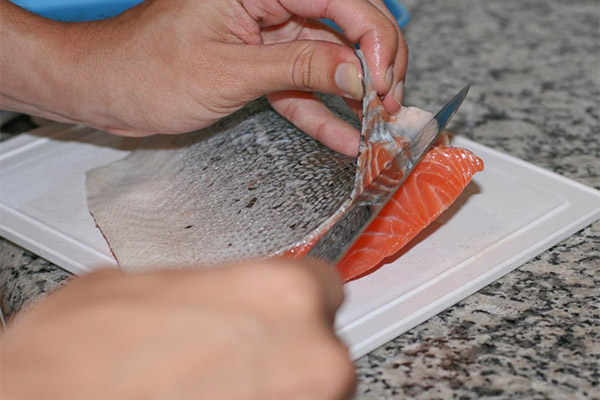
- Making an incision on the abdomen, get rid of the innards.
- Using a knife with a short blade or special for cleaning fish, get rid of scales, cleaning in the direction of the head. If the process is difficult, you can pour boiling water over the salmon.
- Rinse the fish and dry it with a towel.
- Under the gill bone, use a circular motion to separate the head while holding the fin at the neck with the other hand.
- Remove the caudal fin by trimming it into a triangle on both sides.
- Separate the rib bones from the inside by making a slit in the skin and dividing the fish into two halves.
- Remove the backbone, holding it with a cloth or doily so as not to hurt yourself.
- Remove the upper backbone with a sharp knife.
- Cut through the foil, removing the ribs, and separate the carcass.
- Remove the remaining bones, making a slight slope toward the abdomen.
- Separate the skin, starting with the head. To do this, lay the carcass skin side down and, using a sharp knife, cut it off "in one movement".
Next, the fish should be cooked according to the preferences of the cook.
How to cook salmon well: recipes
Fish lovers are unlikely to think about the benefits of the product, enjoying the tender and juicy meat of salmon, cooked by a skillful master. But the recipes for such dishes are quite accessible to ordinary housewives, capable of cooking fish in their own kitchen.
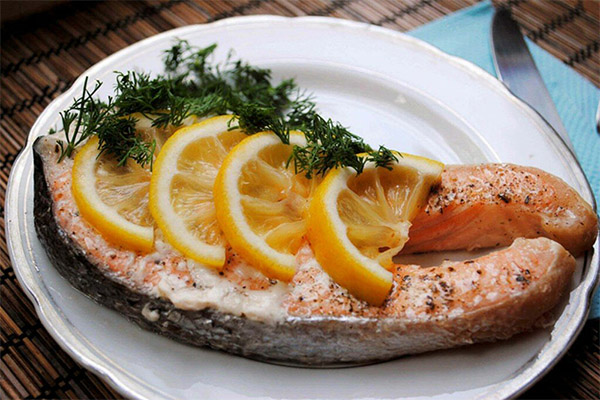
In the oven
Ingredients:
- 0.9 kg of salmon fillets;
- 80 g mustard (Dijon);
- 80 g of liquid honey;
- 10 g dill herbs;
- 60 ml olive oil;
- 15 g garlic;
- 20 ml of lemon juice;
- salt.
Method of preparation:
- Wash and dry all ingredients.
- Remove the garlic from the husks and grate with a fine grater, but not through a press.
- In a bowl combine honey, mustard, garlic and 2/3 of the oil, lemon juice, herbs and salt. Stir all ingredients thoroughly.
- Divide the fillets into five portions and brush each portion with the remaining oil.
- Line a baking tray with parchment and put the fish fillet on it smeared with mustard-honey mixture.
- Put in the oven preheated to 200°C and cook for 10 minutes.
In a pan
Ingredients:
- 300 g salmon fillets;
- 2 tablespoons flour;
- 1 egg;
- 0,5 cup walnuts.
Method of preparation:
- Chop walnuts and divide into two parts.
- In a separate bowl, mix the flour with the egg using a blender, and then add half of the nuts to the mixture.
- Wash and dry the salmon fillets beforehand, then dip them thoroughly in the nut and egg batter and roll them in the nuts.
- Place the fish fillets in the batter and nuts in a heated frying pan and cook for 4 minutes on each side. The fire should be low and the lid of the pan closed during grilling.
On the grill
Ingredients:
- 4 pieces of salmon steak;
- 3/4 cup dill greens;
- 1 tbsp. tarragon;
- 1 tsp. granulated sugar;
- 1 tsp. lemon zest;
- 1 tbsp. vegetable oil without odor.
Method of preparation:
- Grease the steaks with vegetable oil on all sides.
- Mix the rest of the ingredients in a separate bowl.
- Put the fish in the marinade for a quarter of an hour, then put the salmon on a heated grill and cook for 10 minutes.
On the grill
Ingredients:
- 0.75 kg salmon fillets;
- 250g brown sugar;
- 38 ml lemon juice;
- 63 ml olive oil;
- 63 ml soy sauce;
- 38 ml water;
- 2.5 cloves garlic;
- salt.
Method of preparation:
- In a heavy plastic bag, combine all ingredients except fish and mix together thoroughly.
- Cut the salmon into 5 portions and put them into a bag.
- Thoroughly mix the fish with the marinade and put the tied bag in the refrigerator for 3 hours.
- After the time has passed, place the fish on the grill and melted beforehand.
- Cook the dish for about 10 minutes, turning salmon pieces from time to time.
In a steamer.
Ingredients:
- 0.4 kg salmon fillets;
- 5 g lemon zest;
- 5 ml lemon juice;
- 40 g rosemary;
- 0.6 l water;
- salt.
Method of preparation:
- Rinse the fillets into 4 portions, salt, sprinkle with lemon juice and sprinkle the zest, then leave to stand for 7 minutes.
- Pour the water into the multicooker with the rosemary.
- Place a special steam sieve on which to put the salmon.
- Set the toggle switch in the "steam" mode, and cook the dish for about 15 minutes.
What to cook with salmon: Recipes
There are many recipes for a variety of dishes that are made from the amazing meat of salmon. Here are just a few of them.
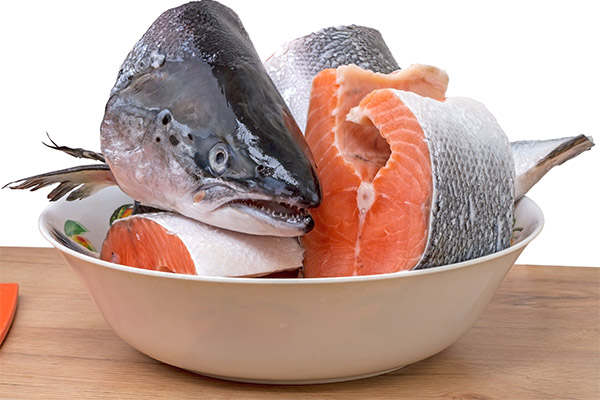
Salad
Ingredients:
- 200 g of lightly salted salmon fillets;
- 100g canned corn;
- 2 tbsp. lemon juice;
- 150g Philadelphia cheese;
- 3 slices of white bread;
- 2 tbsp. vegetable oil;
- 1 avocado;
- oregano;
- basil;
- ground pepper;
- salt.
Method of preparation:
- In a container mix salt, pepper, and oil.
- Cut the white bread into small pieces and soak them in the oil and spice mixture, then fry the breadcrumbs in a pan without adding oil.
- Cut the peeled avocado into cubes and sprinkle with lemon juice.
- Dice the salmon and mix with the cheese.
- Then arrange the dish in layers in the following order: salmon and cheese, avocado, corn and breadcrumbs.
Soup
Ingredients:
- 300 g salmon;
- 280 g tomatoes;
- 450 g potatoes;
- 1 carrot;
- 1 onion;
- 0.5 l of 20% cream;
- dill greens;
- 1 liter water;
- pepper;
- 1-2 tbsp. vegetable oil without odor;
- salt.
Method of preparation:
- Finely chop the onion, grate the carrots with a coarse grater, peel and dice the tomatoes. Dice peeled potatoes as well.
- Add oil to a 3-liter saucepan, heat it up and add onions. When it changes color, add carrots.
- Next, put the tomatoes in the pot and stir-fry for about 3 minutes. Then add water and wait for the liquid to boil.
- After that, put potatoes also to the vegetables and cook the soup for 6 minutes, adding salt.
- When this time has passed, add the fish and pour out the cream in a thin stream. Cook the dish for about 5 minutes. Turn off the heat and season with salt and herbs.
Pasta
Ingredients:
- 300 g salmon fillets;
- 250g tagliatelle pasta;
- 150 ml of cream 20%;
- 2 tbsp. olive oil;
- 10 g parsley greens;
- parmesan cheese;
- pepper;
- salt.
Method of preparation:
- Boil the pasta until cooked through.
- Cut the fish fillets into small pieces and fry them briefly in olive oil, then stir in the herbs.
- Add the cream, salt and pepper. Bring to a boil and simmer for about 2 minutes.
- Mix the pasta into the salmon and portion out, then sprinkle with cheese.
Tartar
Ingredients:
- 300 g salmon fillets;
- 3 heads of shallots;
- 5 green onion feathers;
- ½ avocado;
- 1 tbsp. capers;
- 1 tbsp. lemon juice;
- 1 tsp. soy sauce;
- 1 tbsp. olive oil.
Method of preparation:
- Cut fish into small cubes.
- Onion (both types), capers finely chop.
- In a separate bowl combine oil, juice, sauce and pepper (if necessary) and add to the mixture fish, onions and capers. Stir.
- Add the avocado cubes and place in the refrigerator for 30 minutes.
Quiche
Ingredients:
- 150 g salted salmon;
- 200 g flour;
- 100 g butter;
- 200 ml of cream 20%;
- 4 chicken eggs;
- 5 tablespoons water;
- 150 gr grated cheese;
- 1 onion;
- dill;
- salt.
Method of preparation:
- Combine flour, salt and little and chop with a knife. Then add water (ice water) and knead the dough.
- Roll out the dough and put it into a mold (it is better to take a split version). Let it cool for 15 minutes.
- When cooled, prick the crust with a fork, cover with parchment and sprinkle with peas or beans to keep the shape concave.
- Preheat the oven to 200°C and bake the crust for a quarter of an hour, then get rid of the peas and paper and let the product rest for about 5 minutes.
- Whip the cream and eggs with a blender, add salt and pepper.
- Sauté onion sliced in half rings in olive oil and put it in quiche base. Add slices of salmon and sprinkle the cheese and herbs.
- Pour the egg mixture into the half-finished product and put everything in the oven, where you cook until the golden crust appears.
Cutlets
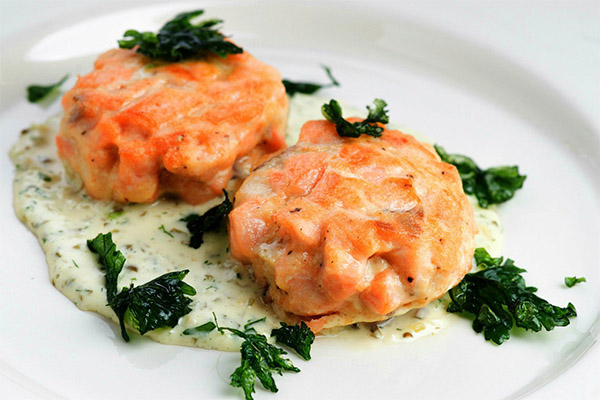
Ingredients:
- 0.5 kg salmon fillets;
- 2 onions;
- 2 eggs;
- 2 tbsp. vegetable oil (and some more for frying);
- dill and parsley greens;
- 0.5 tsp. baking soda;
- 1 tsp. salt.
Method of preparation:
- Grind fish fillets with a blender.
- Onion grate with a grater. Finely chop the herbs.
- Mix all the ingredients.
- Spoon the mass onto a hot griddle and form cutlets.
- Cook on a medium flame until a nice crust is formed.
Bruschetta
Ingredients:
- 150 g salmon fillets;
- 100g fresh cucumbers;
- 3 slices of white bread;
- 50g cream cheese;
- 10 g of 20% cream;
- 10g olive oil;
- 1 lemon;
- oregano;
- pepper;
- arugula;
- parsley greens;
- salt.
Method of preparation:
- Remove skin from cucumber and dice it.
- Also cut the fish into small cubes.
- In a bowl, add the cucumber and juice of ½ lemon to the salmon, then also add the oregano and olive oil. Stir and leave to stand for about 20 minutes.
- Finely chopped greens, add cheese and cream, salt and pepper it, and add the remaining juice of another half lemon. Stir thoroughly.
- Lightly bake the bread in the oven for 5 minutes at 180°C.
- Spread the cheese mixture on the slices of bread and spread the salmon mixture on top.
Riette
Ingredients:
- 0.2 kg smoked salmon fillets;
- 0.5 kg of fresh salmon fillets;
- 50 ml yogurt without additives;
- lemon;
- 80 g sour cream 20%;
- mix of black and white pepper;
- dill greens;
- salt.
For fish broth:
- 700 ml white dry wine;
- 3 bay leaves;
- onion;
- 6 sprigs of parsley.
Method of preparation:
- In a saucepan, combine the alcohol, bay leaves, parsley herbs and boil for 5 minutes.
- Boil fresh fish fillets in broth for about 10 minutes. Cool it down.
- Squeeze the juice out of half a lemon. Finely chop the dill.
- Chop the smoked and boiled salmon finely, removing the skin.
- Purée the boiled fish with a fork and combine with the rest of the ingredients.
- Cover the ready riet with a plastic bag or film and put it in the fridge to keep for at least 4 hours.
- Spread the riet on toasts.
Carpaccio
Ingredients:
- 0.5 kg of fresh salmon fillets;
- 20 g chives;
- 1 fresh cucumber;
- 2 tsp. capers;
- 100 ml olive oil;
- 2 lemons;
- black pepper;
- salt.
Method of preparation:
- Freeze the fillets in the freezer for 60 minutes, then slice into thin, translucent slices and place in a single layer on a serving dish.
- Peel the cucumber and cut it into long thin strips. Then put them on top of the fish.
- Chop the onions with scissors and sprinkle them on top of the dish.
- Wash the capers in water and place them randomly on the fish.
- Squeeze the juice out of the lemons and brush it on all the salmon slices.
- Pour a thin drizzle of olive oil onto a plate.
- Taste and season with salt and pepper, then cover with clingfilm and leave the carpaccio for about 20 minutes in the refrigerator.
Pâté
Ingredients:
- 250 g smoked salmon;
- 250g Philadelphia cheese;
- 2 tablespoons lemon juice;
- black pepper.
Method of preparation:
- Cut the fillet into pieces and combine it in the bowl of a blender with the cheese, lemon juice and pepper, then thoroughly puree.
- Put the ready paste in a serving dish and garnish with red peppers.
Roll
Ingredients:
- 0.4 kg salmon fillets;
- 4 tbsp. 30% sour cream;
- 6 eggs;
- 500 g of frozen green peas;
- 200 g of frozen spinach;
- half a lemon;
- ground black pepper;
- salt.
Method of preparation:
- In the bowl of a blender, combine the salmon, 3 eggs, half the sour cream, a quarter of the lemon juice and the spices, then puree.
- Boil the peas for 3 minutes in salted water, combine them with the spinach, the remaining eggs, half the sour cream and a quarter of the lemon juice. Next, puree the combined ingredients with a blender.
- Grease a casserole dish with oil and lay out the mass in layers - first the fish mass, then the vegetable mass and repeat the process again.
- Then cover the resulting layered product with foil and put the form itself in a larger container, with a thick piece of cloth under the dishes with the future roll.
- Pour the water into a bigger dish, till the middle of the dish with the loaf, and place it in a heated oven up to 180°C for 60 minutes.
- Let cool and put in a fridge.
Shish kebab
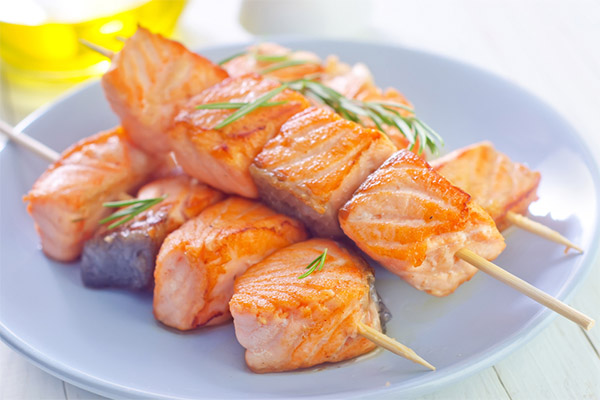
Ingredients:
- 1.5 kg of fresh salmon fillets;
- 1 onion;
- ½ lemon;
- A bunch of coriander;
- 70 g odorless vegetable oil;
- salt.
Method of preparation:
- Combine the chopped onion with the finely chopped cilantro and the rest of the ingredients except the fish.
- Salmon cut into portions and marinate in this marinade for half an hour.
- Thread the filet on skewers or skewers, alternating with tomatoes or other vegetables (if desired).
- Cook over the coals for 9 minutes.
How to salt salmon well at home
Many people like to eat pickled salmon, but you can cook it at home yourself, and the product will be tastier and healthier than the "store" version. In addition, it will save the family budget.
There are different methods of salting, but the simplest and most popular is the cold salting, when the fish is simply poured with salt and sugar and salted.
For salting it is necessary to have 0,5 kg of salmon fillets with skin, 2 tablespoons of common table salt and 1 tablespoon of sugar. Next, you need to rid the fish of excess moisture with paper towels. Then combine the salt and sugar and roll the pieces of salmon in this mass to form a thick crust. Then put the fillets on the skin in a ceramic container and cover with foil. Then place the fish in the refrigerator for 24 hours. During this time, you need to drain the resulting liquid from the dishes with fillets 2-3 times. The next 24 hours rinse the fish and drizzle with vegetable oil.
This method does not take much time, and the result will please the taste. However, you should remember that you can not salt salmon in metal dishes.
Can I Eat Salmon Raw
Carpaccio lovers often wonder about the safety of eating raw salmon fish meat, because such products can infect people with parasites or intestinal viruses. In addition, the fish is capable of absorbing harmful substances of the waters that served as its home. Nevertheless, experts say that raw salmon is quite fit for consumption and practically safe, but only if it lived in salt water, where parasites simply do not survive. But that does not mean that there is no risk of infection. It is necessary to observe a measure and not to abuse the product.
Can animals be given salmon
Not only people like to taste a piece or two of delicate salmon meat. Animals are also big fish eaters, especially cats and dogs. Salmon is also good for the four-legged animals. It can improve the skin and coat of the pet, strengthen the immune system, saturate with minerals and vitamins, and become an excellent source of healthy protein.
Still, experts do not recommend giving salmon to pets raw and skinned to avoid digestive problems. In addition, by consuming the raw product, the animal may well become infected with parasites and become a vector. For this reason, it is better to boil or bake salmon, but without salt and spices. In this form, it will bring the pet only benefits.
Interesting facts
Salmon is an ancient fish, which means that it has a rich history. Many amazing facts are known about it:
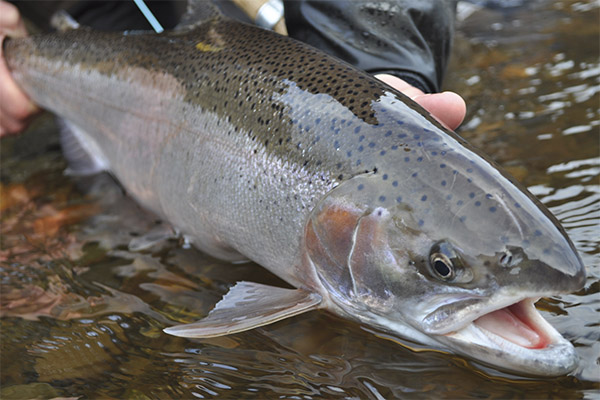
- The pink color of salmon meat is directly related to the diet of the fish, which includes crustaceans that contain a special pigment that colors salmon meat as well.
- The largest member of the salmon family is the chinook salmon, the body length of which can reach 1.5 m.
- The most salted salmon fish tastes like humpback salmon.
- Before spawning, male salmon stop feeding.
- Depending on the habitat, salmon can change color and shape.
- Salmon can leap over the water to 30 cm.
- Salmon can find their birthplace by smell and the moon.
- After spawning, ¾ of the fish die.
This is the kind of amazing fish that lives in the water depths. It is able to heal from ailments and maintain beauty. That's why salmon has won acclaim from foodies around the world and continues its victorious march across the planet.
«Important: All information on this site is provided for informational purposes only. for your own health. Please consult with your health care professional before using any of our recommendations. specialist before applying any of the recommendations. Neither the editors nor the authors shall be liable for any possible harm caused by materials."


